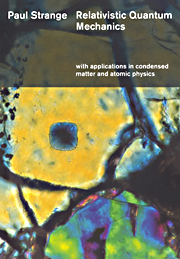Book contents
- Frontmatter
- Contents
- Preface
- 1 The Theory of Special Relativity
- 2 Aspects of Angular Momentum
- 3 Particles of Spin Zero
- 4 The Dirac Equation
- 5 Free Particles/Antiparticles
- 6 Symmetries and Operators
- 7 Separating Particles from Antiparticles
- 8 One-Electron Atoms
- 9 Potential Problems
- 10 More Than One Electron
- 11 Scattering Theory
- 12 Electrons and Photons
- 13 Superconductivity
- Appendix A The Uncertainty Principle
- Appendix B The Confluent Hypergeometric Function
- Appendix C Spherical Harmonics
- Appendix D Unit Systems
- Appendix E Fundamental Constants
- References
- Index
9 - Potential Problems
Published online by Cambridge University Press: 11 January 2010
- Frontmatter
- Contents
- Preface
- 1 The Theory of Special Relativity
- 2 Aspects of Angular Momentum
- 3 Particles of Spin Zero
- 4 The Dirac Equation
- 5 Free Particles/Antiparticles
- 6 Symmetries and Operators
- 7 Separating Particles from Antiparticles
- 8 One-Electron Atoms
- 9 Potential Problems
- 10 More Than One Electron
- 11 Scattering Theory
- 12 Electrons and Photons
- 13 Superconductivity
- Appendix A The Uncertainty Principle
- Appendix B The Confluent Hypergeometric Function
- Appendix C Spherical Harmonics
- Appendix D Unit Systems
- Appendix E Fundamental Constants
- References
- Index
Summary
I believe that physicists gain much of their physics intuition from solving simple model problems explicitly. Apart from the hydrogen atom, this is something that is not often done in relativistic quantum theory books (except the book by Greiner (1990)). In this chapter we set up and solve five simple models that have exact analytical solutions. Furthermore, they are all related to well-known non-relativistic counterparts, and most find application in many areas of physics, particularly solid state physics. These relationships will be pointed out and where appropriate we will also mention the applications and consequences of the models.
There are very few models in quantum mechanics that yield exact solutions, hence any that do are of fundamental interest, the hydrogen atom being, perhaps, the most famous example. The hydrogen atom with the potential V(r) = —Ze2/4πε0r is unique in that it can be solved analytically classically and in both non-relativistic and relativistic quantum theory, with and without spin. This has been discussed in detail in chapters 3 and 8.
The five examples we choose to consider here are the following. Firstly we will solve the Dirac equation for an electron in a one-dimensional well, a relativistic generalization of the non-relativistic particle in a box problem.
Information
- Type
- Chapter
- Information
- Relativistic Quantum MechanicsWith Applications in Condensed Matter and Atomic Physics, pp. 263 - 316Publisher: Cambridge University PressPrint publication year: 1998
